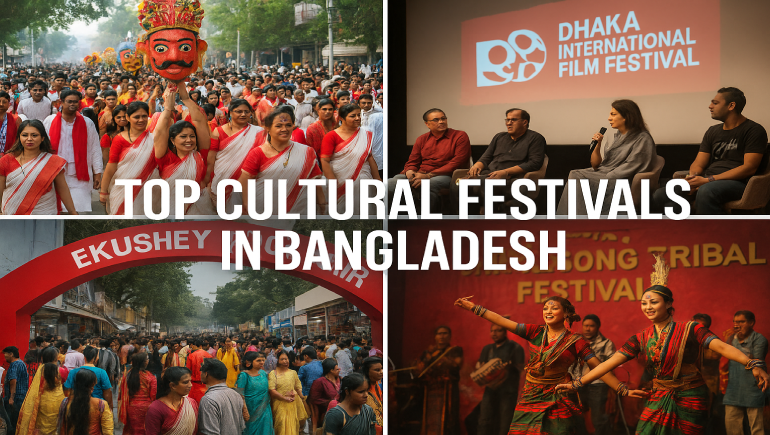Pohela Boishakh is the Bengali New Year and one of Bangladesh’s most iconic cultural festivals. The tradition dates back centuries and is deeply rooted in Bengali identity. Historically, Pohela Boishakh was linked to the agrarian calendar and trade cycles, marking a time of renewal and prosperity.
Pohela Boishakh symbolizes unity and hope. It transcends religion and class, making it a festival for all Bangladeshis. It’s a day when the nation celebrates heritage and looks toward a prosperous future.
Dhaka International Film Festival (DIFF)
Date: Biennially (usually in January or February)
Location: Dhaka
History and Significance:
First held in 1992, DIFF is Bangladesh’s most prestigious international cultural event, celebrating world cinema. It’s a meeting point for filmmakers, critics, and audiences, creating a platform for cultural exchange.
How It’s Celebrated:
- Screening of hundreds of films from around the world, including feature films, documentaries, and shorts.
- Special sections highlighting South Asian cinema and emerging filmmakers.
- Workshops, seminars, and Q&A sessions with filmmakers.
Cultural Impact:
DIFF promotes Bangladesh as a cultural hub for cinema and helps strengthen international film collaborations. It inspires young filmmakers and gives audiences access to diverse cinematic perspectives.
Ekushey Book Fair
Date: February 1 – 28
Location: Bangla Academy, Dhaka
History and Significance:
The Ekushey Book Fair commemorates the Language Movement martyrs of 1952, who fought for the recognition of Bangla as a state language. Since its inception in the 1970s, it has become the largest cultural and literary event in Bangladesh.
How It’s Celebrated:
- Thousands of book stalls selling Bangla and English books.
- Poetry recitations, cultural shows, and discussions.
- Launch of new books by prominent authors.
- Exhibitions showcasing Bangla literature and art.
Cultural Impact:
It is a celebration of the Bangla language and literature, promoting literacy, creativity, and national pride. It reinforces the cultural identity of Bangladesh and encourages literary engagement.
Chittagong Tribal Festival
Date: Usually in December
Location: Chittagong Hill Tracts
History and Significance:
The Chittagong Tribal Festival highlights the heritage of indigenous communities in the Chittagong Hill Tracts. These communities have a rich tradition of music, dance, handicrafts, and rituals.
How It’s Celebrated:
- Folk music and dance performances by tribal communities.
- Exhibitions of traditional crafts such as weaving, bamboo works, and pottery.
- Traditional cuisines are served at open fairs.
- Storytelling about tribal myths and history.
Cultural Impact:
It preserves and promotes the unique cultural identity of Bangladesh’s indigenous communities. It is also a major attraction for cultural tourism.
Nabanna Festival
Date: November (Post-harvest season)
Location: Rural Bangladesh and major cities
History and Significance:
Nabanna is a harvest festival that celebrates the new rice harvest. Rooted in rural traditions, it reflects the agricultural heritage of Bangladesh and the gratitude of farmers.
How It’s Celebrated:
- Village fairs featuring folk music, dances, and drama performances.
- Display of traditional harvest foods and sweets.
- Handicraft exhibitions and rural games.
Cultural Impact:
Nabanna preserves rural art forms and promotes agricultural pride. It also strengthens community bonds and cultural continuity.
Pahela Falgun
Date: Mid-February
Location: Nationwide
History and Significance:
Pahela Falgun marks the arrival of Spring and celebrates the beauty of nature. Its origins are tied to Bengali poetry and art that celebrate seasons and life.
How It’s Celebrated:
- Flower festivals, with vibrant floral decorations.
- Cultural programs featuring music, poetry, and dance.
- People wearing bright floral clothes.
- Outdoor gatherings in parks, gardens, and cultural venues.
Cultural Impact:
Pahela Falgun connects people with nature, creativity, and art. It encourages environmental awareness and brings communities together in joyful celebration.
Bangladesh’s festivals are not just events — they are the heartbeat of the nation’s cultural identity. Each festival tells a story of heritage, tradition, and unity. Whether it’s the timeless celebration of Pohela Boishakh or the colorful joy of Pahela Falgun, these festivals are windows into Bangladesh’s soul.
Visiting these festivals is more than a cultural experience — it is a journey into the history, art, and heart of Bangladesh.













Comments
There are no comments for this Article.